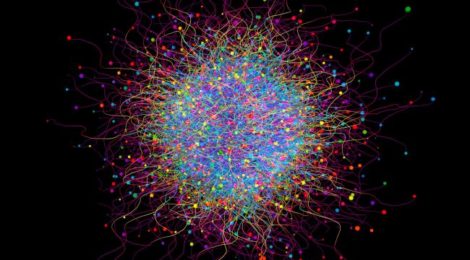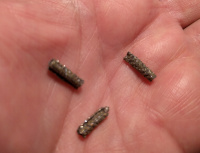
Atom-Ecology Quantum Entanglement Confirmed In New Report In Journal Nature
Complex Mix Of Trillions Of Atoms, Atoms Natural Condition, Then Baking Like A Cookie, Reveals ‘Impossible’ Behaviour
Just As Einstein Described, This ‘Spooky Action’, Provides The Natural Means By Which Complex Atom-Ecology Overcomes ‘Constraints’ On Atomic Behaviour
In our small ceramic fusion reactor tubes, very similar massively complex atom entanglement prevails allowing new clean energy possibilities to emerge.
Classical atomic physics ideas derived from single atoms or just pairs of atoms is the prescription for ‘un-natural’ physics
Scientists have set a world record by creating 15 trillion quantum entangled atoms. This record is big news as it is orders of magnitude greater than any previous number of atoms being made to entangle. But the way they achieved the result is completely unexpected — by most. This important work is featured in the Journal Nature.
The international team of scientists in Spain have used heat instead of near-absolute zero cooling in a highly disorganized and complex mix of materials to achieve this record-breaking quantum entanglement. That’s against popular physics wisdom about atom cooling with entanglement, and it opens new avenues for research and applications. This new work very clearly aligns closely with the methods and findings in our Atom-Ecology cold fusion experiments.
Entanglement, a quantum phenomena Albert Einstein famously described as “spooky action at a distance,” is a process in which two or more particles become linked and any action or change experienced by any of the entangled atoms is instantaneously experienced by the other atoms regardless of how far apart they are. Entanglement lies at the heart of many emerging technologies, such as quantum computing and cryptography, and of course our ‘cold fusion’ technology.
Entangled states are infamous for being impossibly fragile; their quantum links easily broken by the slightest internal vibration (aka heating) or other interference from the outside world. For this reason, scientists attempt to reach the coldest temperatures possible in experiments to entangle jittery atoms; the lower the temperature, the less likely atoms are to bounce into each other and break their coherence.
Not anymore, for the new study, researchers at the Institute of Photonic Science (ICFO) in Barcelona, Spain, took the opposite approach, heating atoms to vastly hotter temperatures than a typical quantum experiment to see if entanglement would persist in a hot and chaotic environment. It did!
“Entanglement is one of the most remarkable quantum technologies, but it is famously fragile,” said Jia Kong, a visiting scientist at ICFO and lead author of the study.
“Most entanglement-related quantum technology has to be applied in a low-temperature environment, such as a cold atomic system. This limits the application of entanglement states. That entanglement can survive in a hot and messy environment is an interesting question (observation).”
Experimental Method

In this tiny atom ecosystem we are able to get closer to defining the real world natural of atoms. That natural behaviour is far different from what we see in spectacular unworldly high-energy super-colliders.
The researchers heated a small glass tube filled with vaporized rubidium and inert nitrogen gas to 350 degrees Fahrenheit (177 degrees Celsius), coincidentally the perfect temperature to bake cookies. At this temperature, the hot cloud of rubidium atoms is in a state of chaos, with millions of atomic collisions taking place every second. Like a cloud of ping pong balls, some of the atoms bounce off each other but all regardless of collisions are in a collective state, transferring their energy and spin. But unlike classical collision-based ideas , this spin does not represent the physical motion of the atoms.
Ed note: Coincidentally this temperature coincides with Atom-Ecology activation temperature and we similarly like a seasoning of an alkali metal in our cold fusion cookie recipe. Great cooks think alike.
To conduct the experiment, the scientists blasted an enclosed amount of radioactive rubidium gas with a laser probe. Like in a fusion reactor, the reactive gas is contained by a magnetic field.
“Here, we study the nature of spin entanglement in this hot, strongly-interacting atomic medium, using techniques of direct relevance to extreme sensing,” they explain, meaning the experiment is structured to have results that can translate directly into the applications this team imagines.
“The results show that high temperatures and strong random interactions need not destroy many-body quantum coherence that collective measurement can produce very complex entangled states.”

‘Atom-Ecology’ cold fusion fuel pellets/cookies are a rather similar fuel mix to the work in this present paper, though ours substitute deuterium for nitrogen. These fuel pellets when placed in our small ceramic tubes yield tens to hundreds of watts of heating lasting for many months and along with definitive gamma spectra. Click to read more.
In the wacky world of quantum mechanics, classical analogies fall apart. The very notion that particles like protons or electrons are rotating solid objects of size and shape doesn’t fit the quantum worldview.
Fortunately, the tiny magnetic fields created by a particle’s spin allow scientists to measure spin in a number of unique ways. One of those involves polarized light, or electromagnetic waves that oscillate in a single direction.
The researchers beam of polarized light that passes through the tube and the rubidium gas interacts with tiny magnetic fields. This light-atom interaction reveals large-scale entanglement between the atoms and the gas. When researchers measure the rotation of the light waves that come out the other side of the glass tube, they can determine the total spin of the gas of atoms, which consequently transfers the entanglement onto the atoms and leaves them in an entangled state.
“With proper conditions, the interaction will produce correlation between light and atoms, and then if we do correct detection, the correlation will be transferred into atoms, therefore creating entanglement between atoms. The surprising thing is that these random collisions didn’t destroy entanglement.”

Artistic illustration of a cloud of atoms with pairs of particles entangled between each other, represented by the yellow-blue lines. In this illustration, a cloud of atoms is shown with pairs of particles entangled between each other, represented by the yellow-blue lines. (Image credit: ICFO)
Just as we have discovered, the “hot and messy” environment inside the glass tube is key to the experiment’s success. The atoms are in what physicists call a macroscopic spin-singlet state, a collection of pairs of entangled particles’ total spin sums to zero. The initially entangled atoms pass their entanglement to each other via collisions in a game of quantum tag, exchanging their spins but keeping the total spin at zero, and allowing the collective entanglement state to persist for at least a millisecond. A millisecond is an eternity of time from the perspective of an atom. For instance, particle A is entangled with particle B, but when particle B hits particle C, it links both particles with particle C, and so on.
“This means that 1,000 times per second, a new batch of 15 trillion atoms is being entangled,” Kong said in a statement. This clearly shows that the entanglement is not destroyed by these random events. This is maybe the most surprising result of the work.”
Because the scientists on the team in Spain are only able to understand the collective state of the entangled atoms, the application of their research seems limited to them. Most quantum entanglement science has largely been confined and directed toward the use of entangled states to covey information/data.
“We hope that this kind of giant entangled state will lead to better sensor performance in applications ranging from brain imaging, to self-driving cars, to searches for dark matter,” Morgan Mitchell, a professor of physics and the lab’s group leader, said in the statement.
Practical Technology Already At Hand

Atom-Ecology fusion pen reactors typically produce tens to hundreds of thermal watts of heat operating in temperature ranges from 150-1500 C.
Here at Atom-Ecology we are far more interested in the fact that atom entanglement allows atoms to instantaneously share energy states amongst the multitudes of entangled atoms. The critical issue in managing atomic energy release has always been the fact that the very large amounts of nuclear energy released in any atomic reaction must be gotten rid of so fast that it produces highly energetic particles or gamma rays. These are the dangerous and deadly radiation we all are so aware of as the seemingly impossibly to manage danger of nuclear power technologies.
Large scale quantum entanglement allows the nuclear energy from a single atom or atomic pair to be instantly distributed, shared, and released by multitudes of entangled atoms and thus released as useful but harmless heat. Thus this seminal paper offers consummate proof of precisely the atomic energy sharing mechanism that ‘cold fusion’ has long be demanded to provide lest it be held to be scientific folly.
The Spanish teams paper was published online May 15 in the journal Nature Communications.
Very cool George, can’t we just admit that a flock of entangled electrons are doing the dirty work here.
And you can assume that there is an Ether and that Einstein was wrong about “Spooky actions at a distance.”
Nah, plenty remains spooky